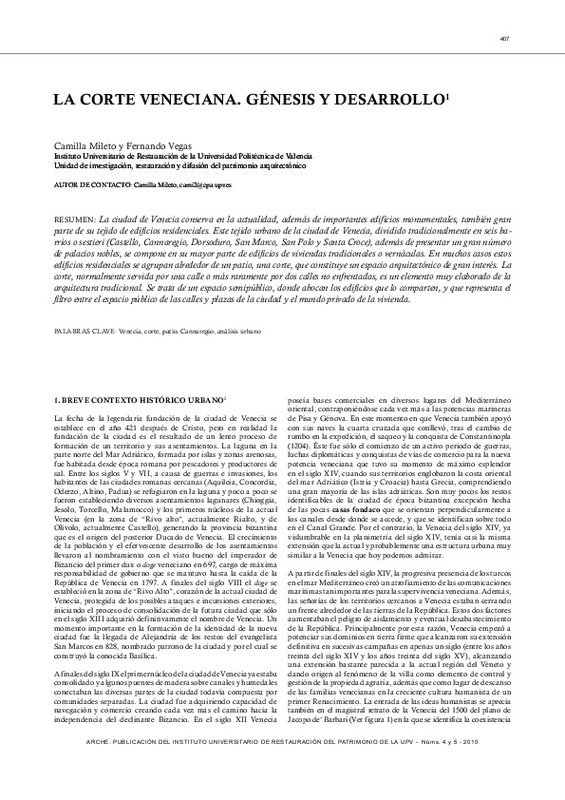JavaScript is disabled for your browser. Some features of this site may not work without it.
Buscar en RiuNet
Listar
Mi cuenta
Estadísticas
Ayuda RiuNet
Admin. UPV
La Corte Veneciana. Génesis y desarrollo
Mostrar el registro sencillo del ítem
Ficheros en el ítem
| dc.contributor.author | Mileto, Camilla
|
es_ES |
| dc.contributor.author | Vegas López-Manzanares, Fernando
|
es_ES |
| dc.date.accessioned | 2013-07-17T07:09:10Z | |
| dc.date.available | 2013-07-17T07:09:10Z | |
| dc.date.issued | 2010 | |
| dc.identifier.issn | 1887-3960 | |
| dc.identifier.uri | http://hdl.handle.net/10251/31173 | |
| dc.description.abstract | La ciudad de Venecia conserva en la actualidad, además de importantes edificios monumentales, también gran parte de su tejido de edificios residenciales. Este tejido urbano de la ciudad de Venecia, dividido tradicionalmente en seis barrios o sestieri (Castello, Cannaregio, Dorsoduro, San Marco, San Polo y Santa Croce), además de presentar un gran número de palacios nobles, se compone en su mayor parte de edificios de viviendas tradicionales o vernáculas. En muchos casos estos edificios residenciales se agrupan alrededor de un patio, una corte, que constituye un espacio arquitectónico de gran interés. La corte, normalmente servida por una calle o más raramente por dos calles no enfrentadas, es un elemento muy elaborado de la arquitectura tradicional. Se trata de un espacio semipúblico, donde abocan los edificios que lo comparten, y que representa el filtro entre el espacio público de las calles y plazas de la ciudad y el mundo privado de la vivienda | es_ES |
| dc.description.abstract | The city of Venice preserves nowadays not only important monumental buildings, but a great part of the historical tissue of its common residential buildings. This tissue has been traditionally divided in six quarters or sestieri (Castello, Cannaregio, Dorsoduro, San Marco, San Polo y Santa Croce) that have a good number of noble palaces among a greater part of traditional and vernacular residential buildings. Frequently, these residential buildings group themselves around a patio, called corte, a very unique and interesting architectural space. The corte, normally served by one at most two not confronted streets, constitutes a very peculiar and elaborated element of the traditional Venetian architecture. It is a semi-public space where the surrounding buildings open their windows that represents the filter between the public space of the streets and squares of the city and the private world of the private dwellings | es_ES |
| dc.language | Español | es_ES |
| dc.publisher | Instituto Universitario de Restauración del Patrimonio de la UPV | es_ES |
| dc.relation.ispartof | Arché | es_ES |
| dc.rights | Reserva de todos los derechos | es_ES |
| dc.subject | Venecia | es_ES |
| dc.subject | Corte | es_ES |
| dc.subject | Patio | es_ES |
| dc.subject | Cannaregio | es_ES |
| dc.subject | Análisis urbano | es_ES |
| dc.subject | Venice | es_ES |
| dc.subject | Courtyard | es_ES |
| dc.subject | Urban analysis | es_ES |
| dc.subject.classification | CONSERVACION Y RESTAURACION DE BIENES CULTURALES (UPV) | es_ES |
| dc.title | La Corte Veneciana. Génesis y desarrollo | es_ES |
| dc.title.alternative | Venetian court. Genesis and development | es_ES |
| dc.type | Artículo | es_ES |
| dc.rights.accessRights | Abierto | es_ES |
| dc.contributor.affiliation | Universitat Politècnica de València. Instituto Universitario de Restauración del Patrimonio - Institut Universitari de Restauració del Patrimoni | es_ES |
| dc.description.bibliographicCitation | Mileto, C.; Vegas López-Manzanares, F. (2010). La Corte Veneciana. Génesis y desarrollo. Arché. (4-5):407-416. http://hdl.handle.net/10251/31173 | es_ES |
| dc.description.upvformatpinicio | 407 | es_ES |
| dc.description.upvformatpfin | 416 | es_ES |
| dc.description.issue | 4-5 | es_ES |
| dc.identifier.eissn | 2445-1150 |






